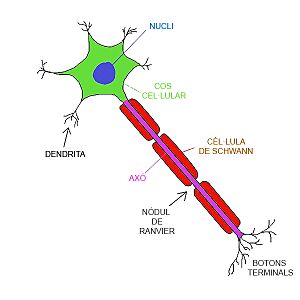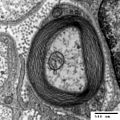Axon facts for kids
An axon is a special part of a neuron, which is a nerve cell. It's like a long, thin wire that sends messages. Axons are very important because they help our brain and body communicate.
The axon carries an electrical message from the main part of the nerve cell (called the soma) to a connection point called a synapse. At the synapse, the message can then pass to other nerve cells or to muscle fibers. This allows your brain to tell your muscles to move, or for different parts of your brain to talk to each other.
Some axons can be very long. In humans, an axon can be over a meter (about 3 feet) long! In larger animals like elephants and whales, they can be even longer.
The electrical signal in an axon is created by tiny particles called ions. These ions move in and out of the cell. This movement creates an electric pulse known as an action potential. This is how the message travels along the axon.
The speed at which these messages travel depends on two things:
- How thick the axon is. Thicker axons send messages faster.
- How much insulation it has.
This insulation is provided by special cells called myelin. Myelin wraps around the axon, much like plastic insulation around an electrical wire. This wrapping is called the myelin sheath. The myelin sheath helps the electrical signal travel much faster and more efficiently along the axon.
The axon was first discovered by a scientist named Otto Deiters.
Images for kids
See also
 In Spanish: Axón para niños
In Spanish: Axón para niños




